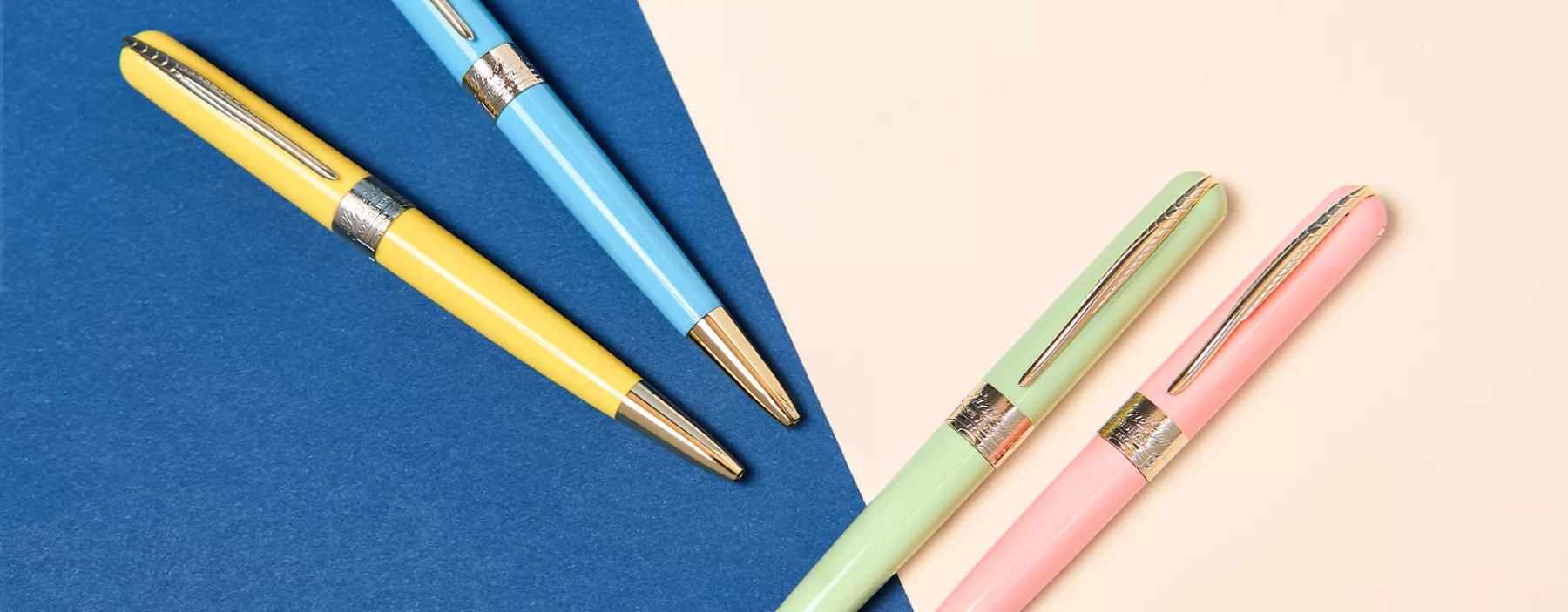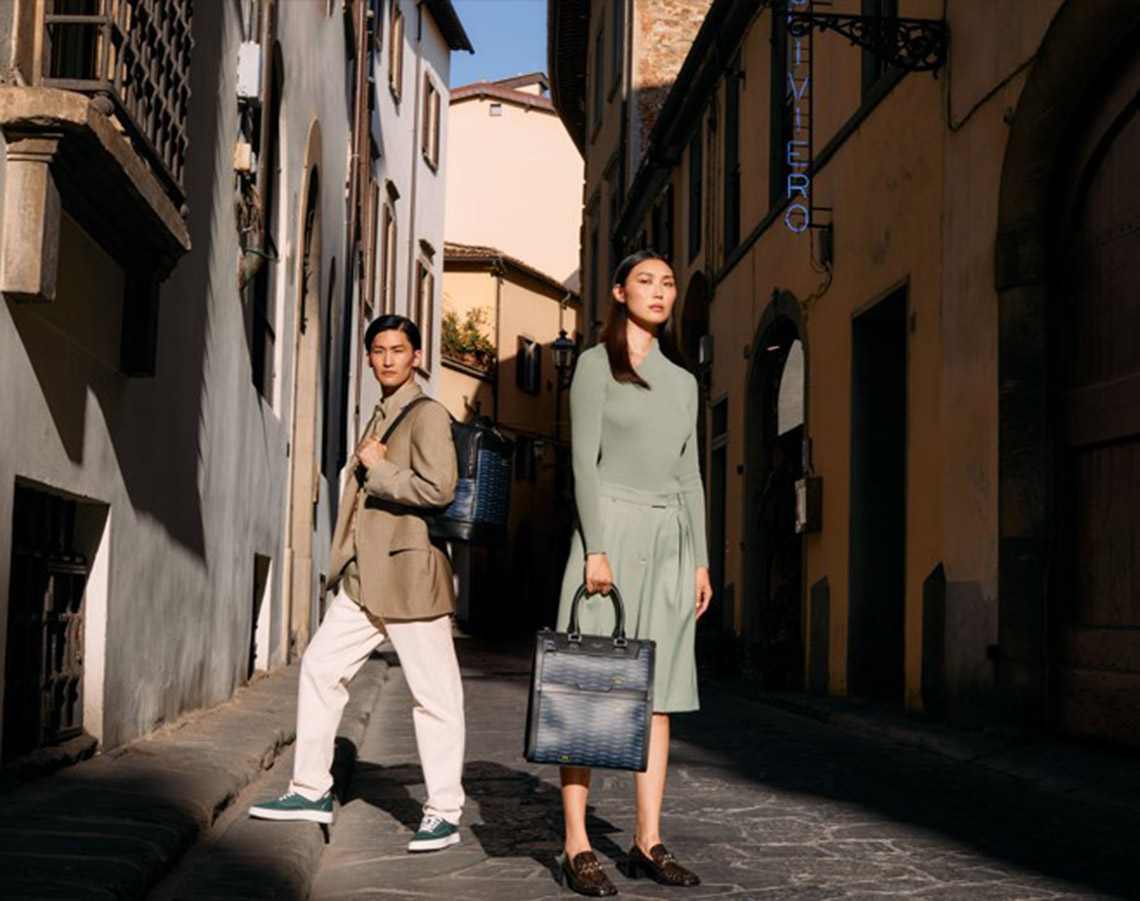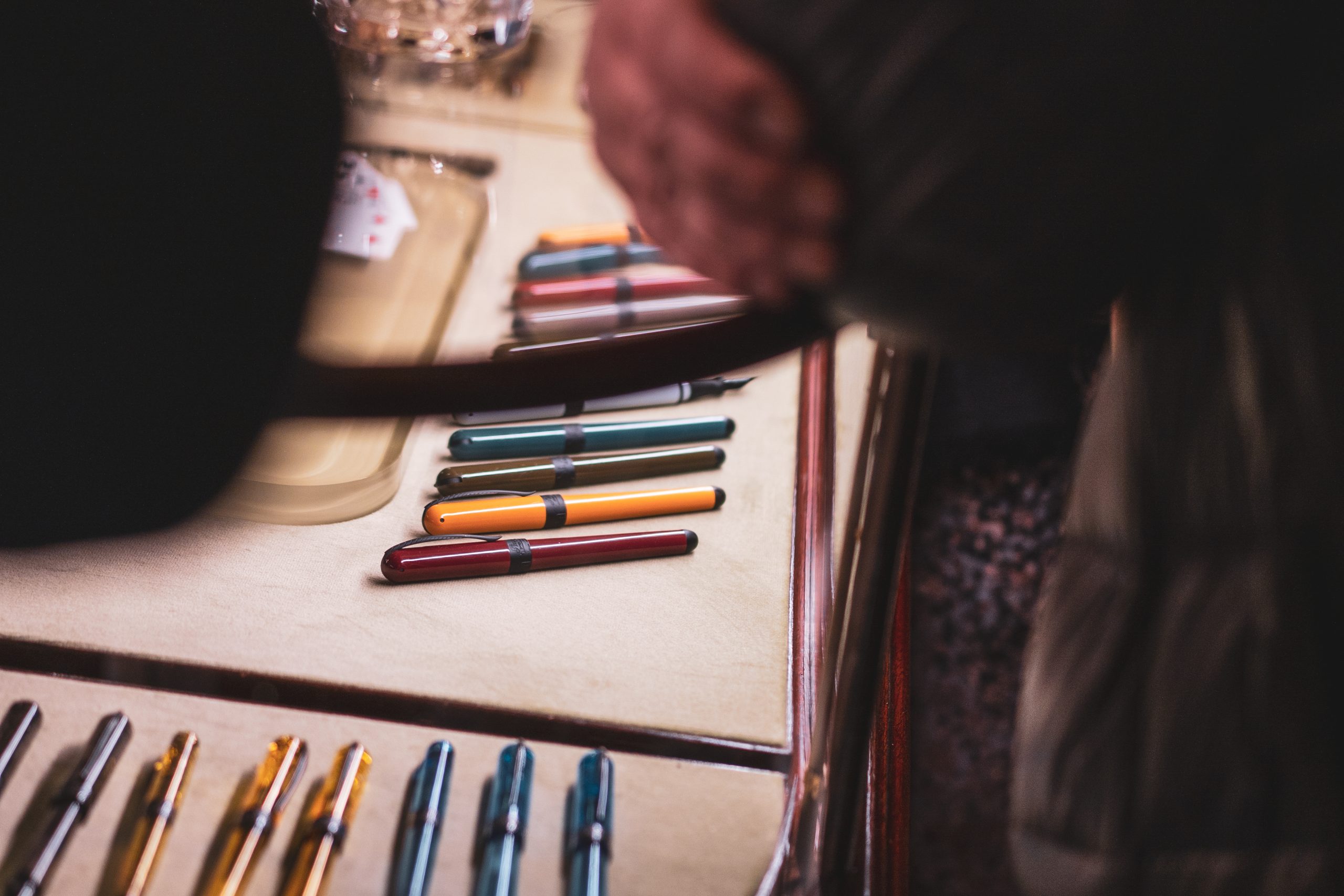How to Refill Your Ballpoint Pen
11 April 2024Ballpoint pens are timeless writing instruments, synonymous with style and practicality. Their versatility makes them perfect for all occasions, from jotting down quick reminders to penning lengthy letters. However, to achieve maximum performance and fully utilize their potential, it is crucial to know how to properly refill a ballpoint pen. Below, you’ll find all the tips to keep your writing tool always ready to capture your most important thoughts. Choosing the Right Nib for Ballpoint Pen Refills Selecting the right nib is a crucial and personalized step that directly impacts your writing experience. To refill your ballpoint pen without errors, consider several factors that play a decisive role, including line thickness, ink type, and the overall durability of the nib. Line Thickness: If you prefer finer lines that allow for precise and detailed writing, opt for an extra-fine or fine nib. If you favor thicker, bolder strokes, a wider, medium nib might be the ideal choice, adding a distinctive touch to your handwriting. Ink Type: Ballpoint nibs offer a wide range of options, including water-based, gel, or oil-based inks. Each has unique characteristics that influence the fluidity of writing, drying time, and water resistance. Durability: A high-quality nib might last longer, ensuring smooth writing over time. Consider how frequently you use your ballpoint pen and select a nib that suits your lifestyle, minimizing the need for frequent replacements. In short, choosing the right nib is a process that combines personal style and practical functionality. Take the time to explore the available options: your ballpoint pen will thus be personalized according to your preferences, transforming every writing moment into a unique and rewarding experience. Preparing Your Workspace for Ballpoint Pen Refill Preparing your workspace is essential for a smooth ballpoint pen refill. By following a few practical tips, you can ensure an efficient and trouble-free refill process. Start by ensuring you have all the necessary tools within reach. These might include the new refill, a soft cloth, a sheet of paper, or a napkin, depending on your preferences. If your ballpoint pen requires a light cleaning before refilling, use the cloth to remove any ink residue from the nib. This ensures a free and even flow during subsequent writing. Place your ballpoint pen on a stable and clean surface. Avoid uneven or sloped surfaces to prevent the risk of falls or accidental movements. The surface should be free from obstacles that could interfere with the flow of the refill. To prevent unwanted ink stains, protect the work surface with a sheet of paper or a napkin. In summary, preparing your workspace is a critical step: ensure you have all the necessary tools, create a clean and organized environment, and protect the work surface to prevent unwanted stains. By following these tips, your ballpoint pen will always be ready for impeccable writing. How to Refill a Ballpoint Pen The crucial moment of inserting the new refill requires precision and attention to ensure a smooth and uninterrupted ink flow. Follow these steps to correctly insert the refill into your ballpoint pen: Check the Nib Type: Before starting, make sure you know the type of nib of your ballpoint pen. Some ballpoint pens have a screw-top, while others require a simple insertion. This information will be crucial for the correct placement of the refill. Ensure the Pen is Empty: Before proceeding with the new refill, ensure that the pen is completely out of ink. This will avoid confusion or contamination with different types of ink. Precisely Position the Refill: If your ballpoint pen requires insertion via a screw-top, position the new refill and gently rotate it clockwise until it is fully screwed in. If your pen requires direct insertion, make sure the refill is properly placed in its housing. Avoid Forcing: Be careful not to push the refill too hard into the pen. A proper installation should be smooth and effortless. Always follow the specific instructions provided by your ballpoint pen manufacturer. Wait a Few Moments: After insertion, wait before using the pen. This allows the ink to flow properly towards the nib, ensuring uniform writing from the first use. Ballpoint Pen Refill: Function Check and Maintenance Once the new refills for ballpoint pens are inserted, it’s time to ensure they function perfectly. Follow these steps: Test on a Sheet of Paper: Write on a sheet of paper to check that the ink flow is smooth and uninterrupted. Fluid and regular writing is a sign of a successful refill insertion. Examine the Nib: Look closely at the nib in the light to ensure there are no obstructions. If you notice ink residue or other particles, gently clean the nib with a soft cloth to maintain a consistent ink flow and prevent future issues. Check the Closure Mechanism: If your ballpoint pen has a closure mechanism, such as a cap, ensure it closes correctly. This will protect the nib and prevent ink leakage when the pen is not in use. Remember to store your ballpoint pen horizontally when not in use to avoid ink leaks and always use the cap, if available, to protect the nib from excessive contamination. Also, avoid pressing too hard during writing to prolong the nib’s life. Regularly check the ink level and replace the refill when necessary for continuous and trouble-free writing. Conclusion In conclusion, the process of refilling top-quality ballpoint pens is not just a practical necessity but a ritual that preserves the beauty and efficiency of such a precious tool. By following the detailed steps of choosing the nib, preparing the workspace, inserting the new refill, and checking its function, you can keep your luxury Pineider ballpoint pen in optimal condition. Aggiungi ai preferiti

Charles Jeffrey, Colab on Arrival
13 March 2024Our capsule collection, born from the collaboration with Charles Jeffrey, the visionary founder of LOVERBOY, marks a decisive moment in our creative journey. Available for online preorder, this collection is the result of a vibrant encounter between two worlds: our commitment to creating luxury products and Jeffrey’s artistic boldness. Launched in January at our Milan flagship store, the collaboration immediately captured the interest of critics and the public, generating enthusiasm and appreciation for its originality and boldness. Jeffrey, with his Scottish background and inexhaustible creative spirit, has worked with us to forge a line that celebrates the union of art, fashion, and high-quality craftsmanship. “Big Beastie,” the unique illustration by Jeffrey, adorns a selection of products ranging from leather goods to accessories, embodying a fantastical creature that captures the gaze with its numerous eyes. “I wanted to do something that was truly representative of myself and my way of seeing,” Charles told journalists during the launch event, “to interact with or wear these products: I went into the Pineider boutique and, trying them on, I wondered how they could become ‘mine’. I wanted them to be completely immersed in my personality.” The collection includes essential pieces for business and leisure, such as the Business Duffle, the Crossbody, a Pouch, a Notebook, a Business Card Holder, and a Passport Holder, available in exclusive shades of bottle green and Mini-Franzi black. These items perfectly integrate with our heritage, demonstrating how quality and timeless elegance are values that resonate well beyond Italian borders, captivating the Anglo-Saxon market as well. The Charles Jeffrey X Pineider “Big Beastie” line is now available exclusively online, offering the chance to purchase limited edition pieces, symbols of unique and distinctive luxury. We invite you to explore this exclusive collection, a true journey through art and elegance that goes beyond the ordinary. The collaboration between us and Charles Jeffrey represents much more than a simple alliance; it’s a bridge between traditions and innovations, a celebration of luxury with a soul and history. Through this new dimension of the capsule, each item becomes an expression of a unique journey in the world of design and customization, offering a renewed and deeply personal luxury experience. Pre-sale available. Aggiungi ai preferiti

Pineider and The Anarchist
22 January 2024From our encounter with Charles Jeffrey, the founder of the LOVERBOY brand, a wildly imaginative creative explosion emerged, giving birth to a monstrous yet fascinating capsule collection. Charles Jeffrey only needs sheets of paper and notebooks within arm’s reach to channel his overflowing creative brilliance. No collection by the Scottish fashion designer has ever come to life without first filling pages upon pages with sketches and thoughts. This is why his instant affection for Pineider was inevitable. From his small room in East London, Charles has gained international acclaim in recent years for his avant-garde designs. His work blends Scottish folklore with the vibrant queer nightlife and music scenes of London into a kaleidoscopic tapestry that speaks to a diverse audience. Deeply inspired by the inherent magic of queerness, Charles conjures dreamlike landscapes in fashion, continually adding new layers to his narrative each season. His designs are imbued with a radical sensibility, emphasizing inclusivity and freedom of expression. Today, thanks to Pineider, Charles brings his unique and anarchic sensibility to a wider audience with a capsule collection of small and medium leather goods. Each design in this collaboration springs from the designer’s hand, featuring whimsical and personal touches like the “Big Beastie” print – a vibrant, multiform creature with fantastical features and numerous eyes symbolizing the deep desires that dwell within human nature and its most hidden passions. The collection includes a Business Duffle, a Crossbody, a Pouch, a Notebook, a Business Card Holder, and a Passport Holder, all in bottle green and black Mini-Franzi. This aligns with the prestigious luxury leather and stationery brand, whose timeless quality is now recognized even in the Anglo-Saxon territories. Aggiungi ai preferiti

Carolina Bucci and Pineider, a Love Story
1 December 2023From the collaboration between Pineider and Carolina Bucci comes the Lucky Stationery Set, a collection of eight cards dedicated to the origins of the brand founded by the Florentine designer. Carolina Bucci has nurtured her passion for handwriting and the history of Florentine stationery for years using Pineider products, to the point of wanting to crown this love story with a collaboration between her eponymous jewelry brand, characterized by playful design and a carefree appeal, and the Florentine brand. Following the pencil set and the precious passion boxes, the new chapter of this adventure is called the Lucky Stationery Set, a collection of eight cards dedicated to the styles with which Carolina launched her brand in the UK 20 years ago. We asked her to tell us about them. What do the eight Lucky Cards represent? “Each of these eight cards represents a wish, and these wishes correspond to the charms on the first eight Lucky Bracelets that I launched 20 years ago. They are the bracelets that gave life to the ‘Carolina Bucci’ brand, and this tribute wants to celebrate the anniversary by starting from the origins, namely from the spirit of expressing wishes.” Why did you choose Pineider for this tribute? “Growing up in Florence, Pineider has always been present in the important occasions of my life: every invitation, every letter received, even my birth announcement was on Pineider stationery. It’s a brand that has a truly unique story, I love the way it has maintained its tradition while not being afraid to venture into new worlds with a contemporary vision.” In your view, what links the world of jewelry to that of handwriting? “Jewelry and handwriting share extremely tactile experiences: much of our daily life is becoming more and more digital, which is why I wanted to maintain physical touchpoints in our lives. I love receiving handwritten notes: they reflect slower, more thoughtful decisions that are really in tune with my way of thinking about jewelry. Neither of these worlds has to do with fashion or trends, but rather with the expression of who you truly are.” Aggiungi ai preferiti

Paper off the Wall: Pineider X Colony
From a shared passion for decoration and handwriting, an exclusive collection of notebooks has been created in collaboration with Colony, an Italian brand of furnishing fabrics and wallpapers. It is a “beyond the wall” cross-contamination, in every sense, between Colony, an Italian brand of furnishing fabrics and wallpapers known worldwide for its contemporary classic style, and Pineider. This unique art notebook collection, born from this meeting, is characterized by three distinct chapters that explore the artistic universe of Colony: Pomegranate, Poppies, and Sogi. Each design encapsulates a unique story, inspired by nature, tradition, and culture. The pomegranate design, for example, a symbol of prosperity and wellbeing, is masterfully represented in a notebook whose cover is adorned with a refined calf leather border, a distinctive sign of Pineider’s tradition. The “Poppies” notebook, on the other hand, is a tribute to spring: the edge of the pages, painted in a bright orange, creates a perfect balance with the brilliant green of the leaves. The third model, “Sogi,” celebrates the influence of Eastern culture with an evocative design inspired by the paintings of Ogata Kōrin. We asked Gabriele Roscioli, the son of the founder Sandro and now at the helm of Colony, to tell us about the creation of this collection. What are the values that Colony and Pineider have in common? “There is a deep affinity between the identities of Pineider and Colony that stems from the ability to narrate classicism in a new and current key, but always sophisticated and elegant. Then, the ‘obsession’ towards high-quality craftsmanship, unique in the world and representative of the diverse Italian creativity. These are the elements that led to a natural meeting between the magic of Pineider notebooks and the refined patterns of Colony, resulting in these precious collectible notebooks.” How important is handwriting in your personal life? “Although, unfortunately, my handwriting is not the best, writing and its tools have always intrigued me, so much so that as a child I had a small collection of fountain pens. For us at Colony, writing, in its expression of drawing, is a fundamental part. The patterns, in fact, all start from hand-drawn designs by our style center and the reality of Pineider is a great source of inspiration for us.” Aggiungi ai preferiti

Ask People who knows: 5 xmas presents by Pineider
30 November 2023The Ideal Surprise? We asked our boutique colleagues what are the most recommended Christmas gifts for enthusiasts in search of originality. Here’s their very own ranking. THE DUFFLE BAG Gloria, senior sales assistant at the Florence boutique, has no doubts: ‘The Pineider duffle bag is one of our unmistakable best sellers. With it, you can’t go wrong, in all its versions. There’s the more rigid, unisex one, designed to hold documents but also as a comfortable weekend travel bag. Perfect for the manager who needs plenty of space without divisions or bellows, but also for the lawyer who needs to carry heavy legal tomes with him at all times, the duffle bag is a perfect shopping companion, in its softer, sporty, and casual version.’ THE NOTEBOOK Alessandra, manager of our Rome store, opts for one of the most classic writing tools: ‘The Pineider Pop notebook, in our pebbled leather with a handy matching elastic. I prefer it in Iconic Rose color because it expresses the more romantic and sweet side of ‘girls’ of all ages and is a color that goes well with everything. Moreover, once personalized, it is embellished with gold initials, giving it an extra touch. A notebook can accompany various moments of the day, the more challenging ones related to work, but also those of leisure and relaxation. My recommendation is to fill it only with beautiful and positive thoughts!’ THE FOUNTAIN PEN Manlio, a new entry at the Pineider Store in Milan, has a soft spot for fountain pens: ‘They can have a thousand looks, but they remain a symbol, that of the attitude of taking our time and giving it to others. With the arrival of smartphones, we have lost the desire to give value to what we write, many, too many, are the words we type every day, not to mention neologisms and Anglicisms. A fountain pen represents nostalgia for the essentiality of writing and for the weight of each word. But without giving up technology, because our pens are innovative, lightweight, agile on the paper, and coated in super-resistant resins.’ THE CARD HOLDER Loredana, our corporate gift expert, always advises small leather goods for a distinctive Christmas present: ‘A business card holder, for example: a compact, elegant, practical object that adapts to any occasion. Pineider card holders are works of art, completely handmade and extremely versatile: there are the simple ones for just credit cards and business cards, or the more structured ones with snap closures and zips to also hold coins. They are the ideal companions for those who love organization without sacrificing style. They are professional, but also personal items. Moreover, like all Pineider products, they can be immediately personalized with the initials of the person to whom they are destined.’ THE 2024 DIARY Paolo, store manager of Pineider Milan, challenges digitalized managers: ‘Giving a paper diary is a bit like going back in time. It is an ancient practice that makes every appointment more ‘yours.’ Calendars on smartphones make events the same, flatten the lived experience, instead the paper diary – whether weekly, monthly, or daily – ties you to the experiences through the act of writing. But most importantly, I don’t know anyone who throws away their old handwritten diaries full of intimate memories. What luxury and taste to go back and read them?’” Aggiungi ai preferiti

Our story, for you
10 November 2023On the occasion of the upcoming Black Friday, Pineider is opening its archives to the public for an exclusive private sale full of unique and iconic pieces. The founding of Pineider is an important chapter in the history of Tuscan tannery, one of the most sought-after and exclusive manufacturing traditions in the luxury world centered around the famous district of Santa Croce. To celebrate this precious DNA, the Florentine brand is preparing a surprise for all leather goods enthusiasts and more: coinciding with the upcoming Black Friday, unique items, rarities, and iconic collections that have placed Pineider at the forefront of high-end Made in Italy will be made available on our digital boutique. This exclusive event will take place in three distinct phases: From November 17 to 29 on pineider.com, it will be possible to register for Early Access, which will give preferential rights to participate in our Private Sales. From November 20 to 23, Black Friday will start and be accessible to all Pineider customers, with a 20% discount on pens and notebooks, and 20% off both small and large leather goods. From November 24 to 26, those with the Early Access coupon will be able to access the Private Sales and enjoy a discount of up to 70% on archive collections. Among the brand’s must-haves that will be available for purchase, there will be no shortage of small and medium leather goods collections featuring the Pineider monogram, some hard-to-find multicolor mini bags for women, travel bags, duffle bags, and a wide selection of men’s and women’s work bags. The best of our story, exclusively for you. Aggiungi ai preferiti

Writing Badly to Self Love
30 October 2023Pineider and Tatuaggimale launch a collaboration dedicated to primal writing, a tribute to the love of a gesture born with the sole purpose of changing the world. With words. The passion for handwriting in all its forms has led Pineider to encounter creatives of all kinds united by the search for a new raison d’être in the digital transformation era, for the oldest form of communication. From these encounters, calligraphy courses, writing workshops, new products, and unconventional shortcuts have emerged. The latest of these features Giovanni Barberis, a videomaker from Milan, who in 2016 gave life to a true artistic movement called Tatuaggimale. In the guise of a novice tattoo artist, almost playfully, Giovanni has legitimized a new expressive format that embraces typographic experimentation and writing on skin. His creations consist of short provocative phrases, quotes, slogans, or simple words expressed through primal styles, as if they were just sketched on a sheet of paper. But beyond the provocation of essentiality, in Tatuaggimale’s works, there is that of meaning, the unsaid, intimacy, and memories. Because each of his words conceals the aspirations, joys, pains, and personal story of those who, by getting it tattooed, have chosen it as a life companion. Drawing inspiration from four of Tatuaggimale’s most disruptive punchlines, Pineider wanted to create a limited edition of its black Jazz notebooks, totaling 100 copies, unveiled during a Halloween party in its Milan boutique. An unconventional project that celebrates the love for a rebellious gesture: sparking a spark in others by transforming thoughts into text. Aggiungi ai preferiti

Would a Pen By Any Other Name Smell As Sweet? (It Seems Unlikely)
16 October 2023Pineider, the luxury leather-goods maker and purveyor of exquisite writing instruments, brings their distinctly Florentine artistry to the New World. By Daniele Delerme Flores On a recent visit to Pineider’s new atelier at Rockefeller Center in the heart of Manhattan – new, of course, being a relative term as the location has been open for more than a year but, then again, the company does trace its history all the way back to 1744 – the interesting juxtaposition of Old World Italian taste, refinement, and sensibility meeting American brashness becomes readily apparent from the moment one enters the charming and rather intimate space. At first glance, the dark mahogany paneling and warm, ambient lighting are nothing if not soothing – a welcome respite from the hustle and bustle of Sixth Avenue just a stone’s throw from the front door and the wall-sized advertisements for Seth Myers and The Tonight Show that are visible through the large glass panel windows at the back of the retail space that look out on an interior hallway of 30 Rockefeller. One would gladly remain indefinitely (but comfortably) ensconced amongst these finely crafted works of art, perusing and admiring. And what works of art there are. Pineider’s emphasis on lifestyle as a luxury purveyor of quality goods is evident upon merely a cursory inspection of the leather luggage set on display near the atelier’s entrance. Leather works range from travel desks and leather-bound notebooks to messenger bags, overnighters, duffles, holdalls, and totes. And then there are the writing instruments, a testament to the skill and imagination of Signor Dante Del Vecchio, the company’s resident “pen expert.” From the resin-based pieces to bright, eye-catching enamels, or the more subdued but still enticing skeleton models, the artistry, attention to detail, and pure love of the craft is apparent in each offering. Perhaps even more importantly for the customer, wielding one of Pineider’s instruments allows the writer to experience the simple act of writing on an altogether different level. Whether one is taking a step back in time to a bygone age with the fountain pen, staying the course with the ballpoint, or trying something off the beaten path with the roller-ball, the feel of a Pineider pen in one’s hand is truly an experience unlike any other. As a writer, my creative process usually begins with a pen and notepad. Over the years, I have found it easier to formulate my thoughts when putting pen to paper, as opposed to fingers to keyboard. Quite simply, I can’t write with a pen faster than my mind can formulate a sentence, so I find the pace of drafting in longhand to be a pleasant one. On the few occasions where I have tried my hand at typing an initial draft via word processor, subsequent drafts invariably require more revisions. To put it bluntly, I suspect this is because I can type faster than I can think (insert “shoulder shrug” emoji here). Recognizing these preferences (or limitations – beauty, after all, is in the eye of the beholder), my incomparable Editor-in-Chief at No Chaser, Karl Edwin Guerre (who, it should be noted, is also a brand ambassador for the company) suggested that I broaden my horizons and consider a luxury writing instrument from the skilled craftsmen at Pineider. With that in mind, I met Guerre on a bright and sunny afternoon at the Rockefeller Center location, where I was introduced to Liz Burghardt, a sales associate who proved to be quite knowledgeable. After explaining the unique peculiarities of my particular writing process, Liz suggested the rollerball model. As it turned out, her observations proved to be quite prescient. And so my journey as a Pineider-enthusiast began. Daniele Delerme Flores is Associate Editor and a contributor to No Chaser (print and online), a luxury lifestyle publication. He has written extensively about men’s style for publications such as The Rake -the Modern Voice of Classic Elegance, and websites like A Suitable Wardrobe. He is also the author of The Best Dressed Man In The Room – A Photographic History of the Sartorially Inclined Goniffs, Gamblers, and Gangsters of the Inter-War Years, 1920-1945, and, more recently, Pretty, A Novel from the East Harlem Cycle. His blog, An Uptown Dandy, remains a frequently cited source of information regarding menswear ephemera. He can also be found on Instagram at @an_uptown_dandy. Aggiungi ai preferiti

The Corporate Gift That Makes the Difference
26 September 2023Offering a mere freebie isn’t enough to foster customer loyalty anymore. From large corporations to small professional firms, the quest for the perfect “cadeau” has become an opportunity to distinguish oneself and tell a story—with generosity. Here’s how Pineider caters to the most discerning businesses. How you surprise your clients reveals what kind of company you are. When it comes to defining the mystique of corporate gifting, it’s not just about “loyalty”; there’s much more at play: brand awareness, the reliability of services and goods offered, recognizability, positioning, and the assertion of a company’s untapped potential towards its customers. Furthermore, the proliferation of low-cost gadget offerings has flattened the originality of corporate gifts, rendering them, for many, a pointless cliché. The world of corporate gifting has now become a premier league, where what distinguishes itself is the prestige of the brand chosen as a partner, craftsmanship, and quality. In Pineider’s century-long history, creating products for businesses, regardless of their size, has held a significant place since its inception. It’s essential to know that a collection of corporate gifts demands the same expertise and level of craftsmanship as the seasonal collections showcased in our physical and digital storefronts. “In fact,” explains Gerardo Viviano, Pineider’s Production Director, “it can be said that the research and resources invested in these projects are even greater. Moreover, it’s not just about corporate gifting; it also includes office accessories, meeting room furnishings, and hotel furnishings, among many other products. It ranges from agendas to notebooks, from pens to small leather goods used as ‘luxury gadgets.’ They turn to Pineider because they seek a prestigious brand with a history and manufacturing tradition equally important to enhance their clientele.” In Pineider, a company receives the same treatment as a customer seeking something unique. “They come to us with their idea,” Gerardo continues, “and we assess the level of personalization together, from the company’s logo on a pen to the customer’s initials, or even a completely new product. This is the most captivating work for our team of artisans, such as the design of a writing desk or a passion box, which involves intricate geometries and materials ranging from wood to paper. Among the emerging businesses, the hotel industry stands out: we create furnishings for the desk and bedside table, pencils, pens, notepads, and hotel letterhead. We are sought after by major corporations, banks and insurance groups, as well as smaller professionals, from notary offices to accountants, for whom we personalize everything from letter paper to business cards.” Aggiungi ai preferiti
